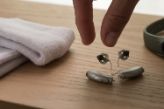Before we dive in, let's explore the history of hearing aids.
1898—The first hearing aid was invented by Miller Reese Hutchison, an American electrical engineer. Named the Akouphone, it was a large device that used carbon transmitters to amplify sound and required the user to wear an earphone, microphone, and battery.
Although we wouldn't consider this "portable" by today's standards, the Akouphone did achieve great success and laid the groundwork for later hearing aid technology.
1920—Decades later, the first wearable electronic hearing aids used vacuum tube technology. These devices were still quite large and bulky, but marked a significant improvement over previous hearing aids.
1948—After World War II, hearing aids began to shrink in size as many other technologies also underwent the same process. The invention of the transistor helped to reduce the size of the hearing aids by replacing vacuum tubes.
The transistor also required less battery power and produced lower levels of distortion compared to vacuum tubes.
In the following decades, there were further advancements.
1970s—The microprocessor and multi-channel amplitude compression device were invented.
1980s—High-speed processors and microcomputers were developed.
1987—The Nicolet Corp. introduced the first commercial digital hearing aid.






